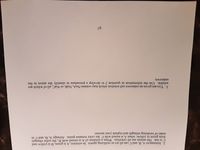
Chemistry
10th Edition
ISBN: 9781305957404
Author: Steven S. Zumdahl, Susan A. Zumdahl, Donald J. DeCoste
Publisher: Cengage Learning
expand_more
expand_more
format_list_bulleted
Question

Transcribed Image Text:2. Substances A, B, and C can all act as oxidizing agents. In solution, A is green, B is yellow and
C is red. The anions are all colorless. When a solution of A is mixed with B', the color changes
from green to yellow, when A is mixed with C the color remains green. Arrange A, B, and C in
order of oxidizing strength and explain your answer.
3. You are given an unknown salt solution which may contain NaA, NaB, or NaC, all of which are
unknown.
soluble. Use the information in question 2 to develop a procedure to identify the anion in the
67
Expert Solution
This question has been solved!
Explore an expertly crafted, step-by-step solution for a thorough understanding of key concepts.
This is a popular solution
Trending nowThis is a popular solution!
Step by stepSolved in 2 steps

Knowledge Booster
Learn more about
Need a deep-dive on the concept behind this application? Look no further. Learn more about this topic, chemistry and related others by exploring similar questions and additional content below.Similar questions
- Choose all of the statements from below which are true about oxidation and reduction. Ooxidation and reduction are opposite processes with respect to bookkeeping electrons. O Oxidation is what happens when an element in a substance increases its oxidation number. Electrons appear on the right side of an oxidation half reaction. An oxidant is an oxidizing agent, which becomes reduced during the course of a redox reaction. O Reduction is what happens when an element in a substance decreases its oxidation number. Electrons appear on the left side of a reduction half reaction. A reductant is an reducing agent, which becomes oxidized during the course of a redox reaction. Karrow_forward1. Balance the following equation using the half-reaction method discussed in experiments 7 and 8. Pay careful attention the condition of the reaction. b. Which element is reduced? SHOW the change in electrons. [ɔisval ON +(HO)nɔ + _ON +nɔ Which element is oxidized? SHOW the change in electrons.arrow_forwardSpecify which of the following are oxidation-reduction reactions, and if it is, identify the oxidizing agent, the reducing agent, the substance being oxidized, and the substance being reduced. If it is not, select No and leave the following boxes blank. Express your answers as a chemical formulas. Omit states-of-matter.arrow_forward
- 4. Cu(s) + 2 AgNO,(aq) → Circle one: VOLTAIC / ELECTROLYTIC Substance oxidized: Substance reduced:arrow_forwardI 2. Substances A, B, and C can all act as oxidizing agents. In solution, A is green, B is yellow and C is red. The anions are all colorless. WVhen a solution of A is mixed with B', the color changes from green to yellow, when A is mixed with C the color remains green. Arrange A, B, and C in order of oxidizing strength and explain your answer. unknown...png B. 五arrow_forward99. Consider the unbalanced redox reaction: MnO4¯¯ (aq) + Zn (s) → Mn²+ (aq) + Zn²+ (aq) Balance the equation and determine the volume of a 0.500 M KMnO4 solution required to completely react with 2.85 g of Zn.arrow_forward
- Using the table of half-reactions, write a balanced equation for a redox reaction where chlorine oxidies iron. Then write a balanced equation for a redox reaction where calcium reduces water to produce hydrogen gas.arrow_forwardFor the redox reaction: What is being oxidized? What is being reduced? (i.e. which one is losing electrons and which is gaining electrons) Cs (s) + NaI(aq) --> CsI (aq) + Na (g)arrow_forwardThe hydroperoxide ion, HO2–(aq), reacts with permanganate ion, MnO4–(aq) to produce MnO2(s) and oxygen gas. Balance the equation for the oxidation of hydroperoxide ion to O2(g) by permanganate ion in a basic solution.arrow_forward
arrow_back_ios
arrow_forward_ios
Recommended textbooks for you
 ChemistryChemistryISBN:9781305957404Author:Steven S. Zumdahl, Susan A. Zumdahl, Donald J. DeCostePublisher:Cengage Learning
ChemistryChemistryISBN:9781305957404Author:Steven S. Zumdahl, Susan A. Zumdahl, Donald J. DeCostePublisher:Cengage Learning ChemistryChemistryISBN:9781259911156Author:Raymond Chang Dr., Jason Overby ProfessorPublisher:McGraw-Hill Education
ChemistryChemistryISBN:9781259911156Author:Raymond Chang Dr., Jason Overby ProfessorPublisher:McGraw-Hill Education Principles of Instrumental AnalysisChemistryISBN:9781305577213Author:Douglas A. Skoog, F. James Holler, Stanley R. CrouchPublisher:Cengage Learning
Principles of Instrumental AnalysisChemistryISBN:9781305577213Author:Douglas A. Skoog, F. James Holler, Stanley R. CrouchPublisher:Cengage Learning Organic ChemistryChemistryISBN:9780078021558Author:Janice Gorzynski Smith Dr.Publisher:McGraw-Hill Education
Organic ChemistryChemistryISBN:9780078021558Author:Janice Gorzynski Smith Dr.Publisher:McGraw-Hill Education Chemistry: Principles and ReactionsChemistryISBN:9781305079373Author:William L. Masterton, Cecile N. HurleyPublisher:Cengage Learning
Chemistry: Principles and ReactionsChemistryISBN:9781305079373Author:William L. Masterton, Cecile N. HurleyPublisher:Cengage Learning Elementary Principles of Chemical Processes, Bind...ChemistryISBN:9781118431221Author:Richard M. Felder, Ronald W. Rousseau, Lisa G. BullardPublisher:WILEY
Elementary Principles of Chemical Processes, Bind...ChemistryISBN:9781118431221Author:Richard M. Felder, Ronald W. Rousseau, Lisa G. BullardPublisher:WILEY

Chemistry
Chemistry
ISBN:9781305957404
Author:Steven S. Zumdahl, Susan A. Zumdahl, Donald J. DeCoste
Publisher:Cengage Learning

Chemistry
Chemistry
ISBN:9781259911156
Author:Raymond Chang Dr., Jason Overby Professor
Publisher:McGraw-Hill Education

Principles of Instrumental Analysis
Chemistry
ISBN:9781305577213
Author:Douglas A. Skoog, F. James Holler, Stanley R. Crouch
Publisher:Cengage Learning

Organic Chemistry
Chemistry
ISBN:9780078021558
Author:Janice Gorzynski Smith Dr.
Publisher:McGraw-Hill Education

Chemistry: Principles and Reactions
Chemistry
ISBN:9781305079373
Author:William L. Masterton, Cecile N. Hurley
Publisher:Cengage Learning

Elementary Principles of Chemical Processes, Bind...
Chemistry
ISBN:9781118431221
Author:Richard M. Felder, Ronald W. Rousseau, Lisa G. Bullard
Publisher:WILEY